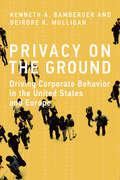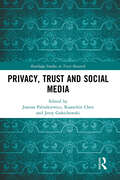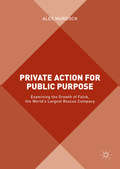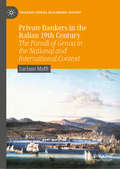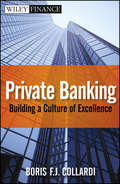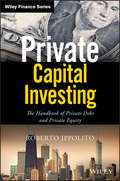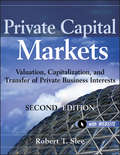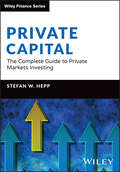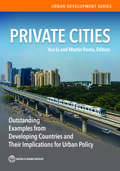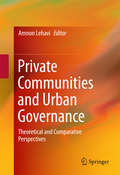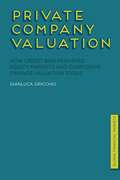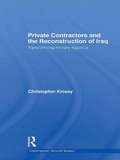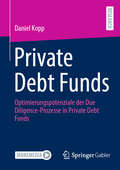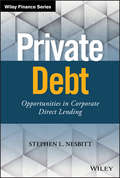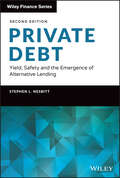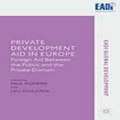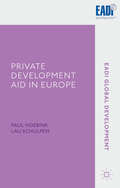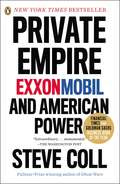- Table View
- List View
Privacy on the Ground: Driving Corporate Behavior in the United States and Europe (Information Policy)
by Kenneth A. Bamberger Deirdre K. MulliganAn examination of corporate privacy management in the United States, Germany, Spain, France, and the United Kingdom, identifying international best practices and making policy recommendations. Barely a week goes by without a new privacy revelation or scandal. Whether by hackers or spy agencies or social networks, violations of our personal information have shaken entire industries, corroded relations among nations, and bred distrust between democratic governments and their citizens. Polls reflect this concern, and show majorities for more, broader, and stricter regulation—to put more laws “on the books.” But there was scant evidence of how well tighter regulation actually worked “on the ground” in changing corporate (or government) behavior—until now. This intensive five-nation study goes inside corporations to examine how the people charged with protecting privacy actually do their work, and what kinds of regulation effectively shape their behavior. And the research yields a surprising result. The countries with more ambiguous regulation—Germany and the United States—had the strongest corporate privacy management practices, despite very different cultural and legal environments. The more rule-bound countries—like France and Spain—trended instead toward compliance processes, not embedded privacy practices. At a crucial time, when Big Data and the Internet of Things are snowballing, Privacy on the Ground helpfully searches out the best practices by corporations, provides guidance to policymakers, and offers important lessons for everyone concerned with privacy, now and in the future.
Privacy, Trust and Social Media (Routledge Studies in Trust Research)
by Jerzy Gołuchowski Joanna Paliszkiewicz Kuanchin ChenTrust is important – it influences new technologies adoption and learning, enhances using social media, new technologies, IoT, and blockchain, and it contributes to the practical implementations of cybersecurity policy in organizations. This edited research volume examines the main issues and challenges associated with privacy and trust on social media in a manner relevant to both practitioners and scholars. Readers will gain knowledge across disciplines on trust and related concepts, theoretical underpinnings of privacy issues and trust on social media, and empirically-validated trust-building practice on social media. Social Media, Privacy Issues and Trust-building aims to bring together the theory and practice of social media, privacy issues, and trust. It offers a look at the current state of trust and privacy, including a comprehensive overview of both research and practical applications. It shows the latest state of knowledge on the topic and will be of interest to researchers, students at an advanced level, and academics, in the fields of business ethics, entrepreneurship, management of technology and innovation, marketing, and information management. Practitioners can also use the book as a toolbox to improve their understanding and promote opportunities related to building social media trust while taking into consideration of privacy issues.
Privacy, Trust and Social Media (Routledge Studies in Trust Research)
by Jerzy Gołuchowski Joanna Paliszkiewicz Kuanchin ChenTrust is important – it influences new technologies adoption and learning, enhances using social media, new technologies, IoT, and blockchain, and it contributes to the practical implementations of cybersecurity policy in organizations. This edited research volume examines the main issues and challenges associated with privacy and trust on social media in a manner relevant to both practitioners and scholars. Readers will gain knowledge across disciplines on trust and related concepts, theoretical underpinnings of privacy issues and trust on social media, and empirically-validated trust-building practice on social media. Social Media, Privacy Issues and Trust-building aims to bring together the theory and practice of social media, privacy issues, and trust. It offers a look at the current state of trust and privacy, including a comprehensive overview of both research and practical applications. It shows the latest state of knowledge on the topic and will be of interest to researchers, students at an advanced level, and academics, in the fields of business ethics, entrepreneurship, management of technology and innovation, marketing, and information management. Practitioners can also use the book as a toolbox to improve their understanding and promote opportunities related to building social media trust while taking into consideration of privacy issues.
Privat Immobilien verkaufen: In acht Schritten zum erfolgreichen Notartermin
by Raimund WurzelDieses Buch gibt Privatpersonen wertvolle Unterstützung bei der Veräußerung ihrer Wohnung oder ihres Hauses. Systematisch und gut verständlich führt Raimund Wurzel den Leser durch die einzelnen Schritte bis zur Unterzeichnung des Kaufvertrages. Der Weg beginnt mit grundlegenden Überlegungen zu den Motiven und zu ersten Preisberechnungen, über das angemessene Herrichten und die wirkungsvolle Präsentation bis zur Klärung der entscheidenden finanziellen und rechtlichen Fragen. Die vielen Beispiele und praktischen Tipps schaffen ein tiefgehendes Verständnis für die komplexe Thematik. Am Ende des Buches der Leser wertvolle Einblicke Raimund Wurzel intensiv der Maklerbranche. Er vermittelt dem Verbraucher wichtige Details aus der Innensicht der Branche und räumt mit Vorurteilen auf. Für diese Neuauflage hat der Autor sein Werk auf den aktuellen Stand gebracht und dabei viele neue rechtliche Rahmenbedingungen eingearbeitet, wie zum Beispiel das neue Gesetz über die Verteilung von Maklerkosten bei der Vermittlung von Kaufverträgen über Wohnungen und Einfamilienhäuser“.
Privat Immobilien verkaufen: In acht Schritten zum erfolgreichen Notartermin
by Raimund WurzelDieses Buch gibt Privatpersonen wertvolle Unterstützung bei der Veräußerung ihrer Wohnung oder ihres Hauses. Systematisch und gut verständlich führt Raimund Wurzel den Leser durch die einzelnen Schritte bis zur Unterzeichnung des Kaufvertrages. Der Weg beginnt mit grundlegenden Überlegungen zu den Motiven und zu ersten Preisberechnungen, über das angemessene Herrichten und die wirkungsvolle Präsentation bis zur Klärung der entscheidenden finanziellen und rechtlichen Fragen. Die vielen Beispiele und praktischen Tipps schaffen ein tiefgehendes Verständnis für die komplexe Thematik. Am Ende des Buches der Leser wertvolle Einblicke Raimund Wurzel intensiv der Maklerbranche. Er vermittelt dem Verbraucher wichtige Details aus der Innensicht der Branche und räumt mit Vorurteilen auf. Für diese Neuauflage hat der Autor sein Werk auf den aktuellen Stand gebracht und dabei viele neue rechtliche Rahmenbedingungen eingearbeitet, wie zum Beispiel das neue Gesetz über die Verteilung von Maklerkosten bei der Vermittlung von Kaufverträgen über Wohnungen und Einfamilienhäuser“.
Private Action for Public Purpose
by Alex MurdockThis book analyses the private provision of rescue and emergency services, and focuses on the emergence of the world's largest rescue company, Falck. The author's structured academic perspective is informed through close co-operation with Falck, which operates in 44 countries and across 6 continents. The chapters examine aspects of reliability, culture, innovation, trust, governance and business development within rescue and emergency services, including differentiation, internationalisation and globalisation. Drawing on detailed case studies of Falck's global work in the USA, Columbia, India and Denmark, Private Action for Public Purpose is instructive for students and researchers of business and management, and will provide value for emergency responders, managers, policy-makers and organisations involved in emergency response and crisis management.
Private Actors in International Investment Law (European Yearbook of International Economic Law)
by Katia Fach GómezThis book presents the first critical review of the less frequently addressed stakeholders in international investment law. Focusing on private actors, including but not limited to lawyers, experts, funders, civil society, the media and scholars, the book highlights the variety of actors that help shape international investment law and demonstrates how best to manage their interactions in order to achieve synergies and enhance the legitimacy of this pluralistic field.
Private Bankers in the Italian 19th Century: The Parodi of Genoa in the National and International Context (Palgrave Studies in Economic History)
by Luciano MaffiThe book analyses the role of private bankers who were pivotal in modernizing the economic and financial system of Italy in the XIX century. To achieve this they needed to interact with the international haute banque to organize and place the public loans and the large investments associated with the joint-stock companies. The theme of reputation, which is currently at the centre of the historiographical debate, is fundamental for the study of the private banker figures, whose professional success is linked to the limitless trust accorded to them by their circle of personal contacts. Historiography has studied the role of Italian bankers in the trade, credit and international finance during the modern age (XVI-XVIII centuries), but it has not analysed the banking system in the XIX century and its national and international relations. The case study of Banca Parodi of Genova fills the historiographical gap concerning the role of private bankers and banking institutions in Italy, highlighting the network between the Parodi family and the international haute banque; one of the most emblematic cases is the Rothschild family. The book presents a re-elaborates series of unpublished data, placing them at the disposal of the scientific community and analyses the role of private bankers in the development of Italian banking institutions in the XIX century to launch a scientific debate.
Private Banking
by Boris F.J. CollardiAn insightful overview of the keys to world-class client service in the private banking sector As the number of wealthy individuals around the world increases, private banking and wealth management companies have grown to keep pace. After the fast growth the long term success is predicated on both winning and keeping clients, making a client-centric model a must. Private Banking: Building a Culture of Excellence provides a clear, easy-to-follow guide to building a committed base, written by an industry expert. Presenting an overview of the elements required to build a successful and client-focused private bank that delivers the kind of care and excellence wealthy clients demand, the book even includes real-life examples for a better understanding of concepts and, to help you achieve your goal. Outlines how to implement a practical strategy for success in the growing private banking sector Explores the key drivers in the private banking industry as well as the most recent developments in the environment to help you stay on top of customer demands Includes case studies and other resources to show the keys to private banking done right in action Private Banking provides useful, hands-on advice for building a strong, lasting business in the private banking sector.
Private Banking and Wealth Management Futures 2030: Greater China Perspectives (SpringerBriefs in Finance)
by Jörn H BühringThis book engages the reader around different perspectives between forecasting and foresight in strategic design, drawing insights derived from a futures study that can be applied in form of a design-inspired foresight approach for designers and interdisciplinary innovation teams increasingly called upon to help envisage preferable futures. Demonstrating this process in applied research, the book describes a 2016 Financial Services industry futures study to the year 2030. An industry increasingly at risk in dealing with uncertainty, the Financial Services sector, is a core pillar of economic activity in most markets, such as greater China, and inherent within are major drivers of change linked to consumer behaviors, new technology and disruptive business models. While the financial services industry exemplifies an ideal case for design-inspired foresight, the aims of this book are primarily to establish the peculiarities between traditional forecasting applications and a design-inspired foresight visioning approach as strategic design activities for selecting preferable futures. Underlining the contribution of this book is the value of design futures thinking as a creative and divergent thought process, which has the potential to respond to the much broader organizational reforms needed to sustain in today’s rapidly evolving business environment.
Private Banking in Europe: Serious Wealth (Routledge International Studies in Money and Banking)
by Lynn BickerPrivate banking is one of the highest growth and most profitable financial businesses in Europe. A large proportion of the market remains untapped and the 1990s are likely to bring significant expansion in developing countries. Private Banking in Europe provides new insights into the private banking industry, its growth and future, and emerging opportunities for private bankers and their clients. It debates the importance of global and local service; the potential dichotomy between the wealthy and the successful, and considers the private banking industry. A comparison of key players and their chosen markets and strategies is complemented by an exploration of the growth of intermediaries and unexpected competitiors. The work also includes a study of non-European influences. The book offers a valuable insight into private banking, through the eyes of the bankers themselves. The final chapter is devoted to private bankers' own view of their industry, their competition and future directions.
Private Capital Investing: The Handbook of Private Debt and Private Equity (Wiley Finance)
by Roberto IppolitoA step-by-step, comprehensive approach to private equity and private debt Private Capital Investing: The Handbook of Private Debt and Private Equity is a practical manual on investing in the two of the most common alternative asset classes (private equity and private debt) and provides a unique insight on how principal investors analyze investment opportunities. Unlike other textbooks available in the market, Private Capital Investing covers the various phases that principal investors follow when analyzing a private investment opportunity. The book combines academic rigor with the practical approach used by leading institutional investors. Chapters are filled with practical examples, Excel workbooks (downloadable from the book website), examples of legal clauses and contracts, and Q&A. Cases are referred at the end of every chapter to test the learning of the reader. Instructors will find referrals to both third-party cases or cases written by the author. • Covers analytical tools • Includes the most common methods used to structure a debt facility and a private equity transaction • Looks at the main legal aspects of a transaction • Walks readers through the different phases of a transaction from origination to closing Bridging the gap between academic study and practical application, Private Capital Investing enables the reader to be able to start working in private equity or private debt without the need for any further training. It is intended for undergraduates and MBA students, practitioners in the investment banking, consulting and private equity business with prior academic background in corporate finance and accounting.
Private Capital Markets
by Robert T. SleePraise for Private Capital MarketsValuation, Capitalization, and Transfer of Private Business Interests"In the years since publication of the first edition of Private Capital Markets, the concepts and ideas that it presents have been widely accepted by progressive members of the business valuation community. Now with the Second Edition, author Rob Slee has included empirical data on capital markets for midsized businesses. This book remains a must for everyone involved in appraising, buying, selling, or financing privately owned businesses."-Raymond C. Miles, founder, The Institute of Business Appraisers"The Graziadio School of Business has used the Private Capital Markets book for several years with great success. This course, along with the Pepperdine Private Capital Markets Survey project, has helped our students better prepare for careers in middle market companies."-Linda Livingstone, Dean of the Graziadio School of Business and Management,Pepperdine University"Our international association of independent M&A professionals recommends this text as the most comprehensive foundation for understanding the private capital marketplace. This book is essential reading for middle market M&A advisors, investors, and other decision-makers in the private capital markets." -Mike Nall, founder, Alliance of M&A AdvisorsA practical road map for making sound investment and financing decisions based on real experiences and market needsNow fully revised and in a second edition, Private Capital Markets provides lawyers, accountants, bankers, estate planners, intermediaries, and other professionals with a workable framework for making sound investment and financing decisions based on their own needs and experiences.This landmark resource covers: Private business valuation Middle market capital sources The business ownership transfer spectrum And much morePrivate Capital Markets, Second Edition surveys the private capital markets and presents the proven guidance you need to navigate through these uncharted waters.
Private Capital and Public Policy: Standard & Poor's Sovereign Credit Ratings
by Christopher M. Bruner Rawi AbdelalDescribes Standard & Poor's sovereign credit ratings business. Provides background on the history of credit ratings agencies, the meaning of credit ratings, the expansion of the sovereign ratings business over recent decades, and the market for credit ratings. Also, discusses current debates in the United States and elsewhere relating to the use of credit ratings in financial and prudential regulation.
Private Capital: The Complete Guide to Private Markets Investing (The Wiley Finance Series)
by Stefan W. HeppIn Private Capital: The Complete Guide to Private Markets Investing, renowned private markets investor and expert Dr. Stefan W. Hepp delivers an insightful and comprehensive exploration of the history, nature, and influence of private market investing. The author offers a robust examination of the key practical and conceptual issues faced by investors as they move forward into the future. In the book, you'll find fulsome discussions of the rise of private market investment following the conclusion of World War II, as well as why the limited partnership became the dominant investment vehicle for private equity. You'll also discover the importance of the convergence of technology, government, academia, and venture capital that came to define what we now know as Silicon Valley. The book includes: Explanations of the emergence of buyout firms, as well as why and how buyouts differ from other forms of mergers and acquisitions Examinations of the explosive growth of private equity and other private asset classes since the turn of the millennium Discussions of the issues set to dominate the future of private markets, including ESG investing, value creation, unicorns, special purpose acquisition companies (SPACs), and more A must-read book for regulators, investors, asset managers, entrepreneurs, founders, and other businesspeople, Private Capital will earn a place on the bookshelves of anyone with a stake or interest in private equity and other private asset classes.
Private Cities: Outstanding Examples from Developing Countries and Their Implications for Urban Policy (Urban Development)
by Yue Li Martin RamaInstitutional constraints and weak capacity often hamper the ability of local governments in developing countries to steer urbanization. As a result, there are not enough cities to accommodate an unabated rural-urban migration and many of those that exist are messy, sprawling, and disconnected. The flipside is the emergence of entire cities--more than gated communities or industrial parks--led in whole or in part by private actors. To date, little systematic research has been conducted on the conditions that are necessary for such unusual entities to emerge, on the roles played by private actors, or on the consequences for efficiency and equity. 'Private Cities: Outstanding Examples from Developing Countries and Their Implications for Urban Policy' aims to fill this gap. Using an analytical framework that draws on urban economics and political science, it includes inventories of private cities in the Arab Republic of Egypt, India, Indonesia, and Pakistan and provides structured reviews of 14 outstanding examples across all developing regions. Nongovernment actors turn out to be diverse--they include not only major companies and large developers but also business associations, civil society organizations, and even foreign countries. The way local governments interact with these nongovernment actors varies as well, from deliberate neglect to joint ventures. Private actors take on some--but not all--local government functions, while at times embracing unconventional roles. And while private cities tend to be economically successful, they can lead to environmental degradation, social segregation, and even institutional secession. Increasing the capacity of local governments in developing countries will take time.Along the way, inefficient spatial development patterns may be locked in. There is a case for selectively tapping into the comparative advantage of significant private actors while actively using policy tools to avoid the potential shortcomings. In the spirit of a publicprivate partnership for urbanization, land value capture would be at the center of this approach.
Private Communities and Urban Governance
by Amnon LehaviThis book offers an interdisciplinary and comparative study of the complex interplay between private versus public forms of organization and governance in urban residential developments. Bringing together top experts from numerous disciplines, including law, economics, geography, political science, sociology, and planning, this book identifies the current trends in constructing the physical, economic, and social infrastructure of residential communities across the world. It challenges much of the conventional wisdom about the division of labor between market-driven private action and public policy in regulating residential developments and the urban space, and offers a new research agenda for dealing with the future of cities in the twenty-first century. It represents a unique ongoing academic dialogue between the members of an exceptional group of scholars, underscoring the essentially of an interdisciplinary and comparative approach to the study of private communities and urban governance. As such, the book will appeal to a broad audience consisting of policy-makers, practitioners, scholars, and students across the world, especially in developing countries and transitional and emerging economies.
Private Company Valuation
by Gianluca OricchioThe recent crisis in financial markets has seen a gradual erosion of risk-free asset classes. In equity markets the credit risk has reached a critical level in valuation. Here a new cost of equity method for private companies is presented based on the pricing of junior subordinated notes. Global business cases are illustrated to support this.
Private Contractors and the Reconstruction of Iraq: Transforming military logistics
by Christopher KinseyThis book explains how and why the US and UK governments became so dependent upon military contractors during the war in Iraq. <P><P>It also examines the ramifications this new dependency will have on future military operations, as the conflict in Iraq has shown that private contractors are now indispensable to the attainment of both the military and political objectives of war.
Private Debt Funds: Optimierungspotenziale der Due Diligence-Prozesse in Private Debt Fonds
by Daniel KoppDiese Studie gibt einen umfassenden Überblick in die Arbeit von Private Debt Fonds, die historischen Marktentwicklungen sowie die regulatorischen Gegebenheiten innerhalb welcher sich Private Debt Fonds und deren Investoren bewegen. In diesem Zusammenhang ergibt sich die Fragestellung, welche Stärken und Schwächen die verwendeten Due Diligence-Verfahren der Private Debt Fonds innehaben und welche Verbesserungsoptionen für bestimmte Arten von Private Debt Fonds zur Erreichung ihrer strategischen Zielsetzungen empfehlenswert sind. Auf Grundlage einer umfassenden Studie werden hier die Haupteinflussfaktoren der Due-Diligence-Qualität in Private Debt Fonds vorgestellt und analysiert.
Private Debt: Opportunities in Corporate Direct Lending (Wiley Finance)
by Stephen L. NesbittPrivate Debt: Opportunities in Corporate Direct Lending provides investors with a single, comprehensive resource for understanding this asset class amidst an environment of tremendous growth. Traditionally a niche asset class pre-crisis, corporate direct lending has become an increasingly important allocation for institutional investors—assets managed by Business Development Company structures, which represent 25% of the asset class, have experienced over 600% growth since 2008 to become a $91 billion market. Middle market direct lending has traditionally been relegated to commercial banks, but onerous Dodd-Frank regulation has opened the opportunity for private asset managers to replace banks as corporate lenders; as direct loans have thus far escaped the low rates that decimate yield, this asset class has become an increasingly attractive option for institutional and retail investors. This book dissects direct loans as a class, providing the critical background information needed in order to work effectively with these assets.
Private Debt: Yield, Safety and the Emergence of Alternative Lending (Wiley Finance)
by Stephen L. NesbittAn essential resource for creating outsized returns in the private debt markets In Private Debt II: Finding Yield in a Zero Interest World, renowned investment advisor and industry leader Stephen Nesbitt delivers yet another essential resource for investors seeking to acquire private debt options in the investment market, including corporate direct lending, asset-backed lending, mezzanine lending, royalties, venture debt, structured credit (CLOs), specialty finance, and structured equity. Building on the success and popularity of Private Debt: Opportunities in Corporate Direct Lending, this latest edition of the author’s flagship text helps readers understand this complex and rapidly growing asset class. The book also offers: Explorations of the opportunities, relevant risks, and historical yield provided by private debt Discussions of a variety of loan investment vehicles, including the Business Development Company structure Strategies for structuring a direct loan portfolio and how to fit it into your overall investment strategyA can’t-miss resource for serious investors looking for opportunities to earn higher yields than those offered by traditional index funds while still retaining reasonable safety of principle and liquidity, Private Debt II will undoubtedly become the go-to guide for anyone looking for tried and tested debt investment strategies.
Private Development Aid in Europe
by Paul Hoebink Lau SchulpenThe authors present anoverview of private development aid in Belgium, Denmark, Finland, France, Ireland, Italy, the Netherlands, Spain, and the EU as a whole. They illustrate how private aid organisations receive support as well as the relations they have with their respective governments. "
Private Development Aid in Europe: Foreign Aid between the Public and the Private Domain (EADI Global Development Series)
by Paul HoebinkThe authors present an overview of private development aid in Belgium, Denmark, Finland, France, Ireland, Italy, the Netherlands, Spain, and the EU as a whole. They illustrate how private aid organisations receive support as well as the relations they have with their respective governments.
Private Empire
by Steve CollAn "extraordinary" and "monumental" exposé of Big Oil from two-time Pulitzer Prize winner Steve Coll (The Washington Post) In this, the first hard-hitting examination of ExxonMobil--the largest and most powerful private corporation in the United States--Steve Coll reveals the true extent of its power. Private Empire pulls back the curtain, tracking the corporation's recent history and its central role on the world stage, beginning with the Exxon Valdez accident in 1989 and leading to the Deepwater Horizon oil spill in the Gulf of Mexico in 2010. The action spans the globe--featuring kidnapping cases, civil wars, and high-stakes struggles at the Kremlin--and the narrative is driven by larger-than-life characters, including corporate legend Lee "Iron Ass" Raymond, ExxonMobil's chief executive until 2005. A penetrating, news-breaking study, Private Empire is a defining portrait of Big Oil in American politics and foreign policy.
